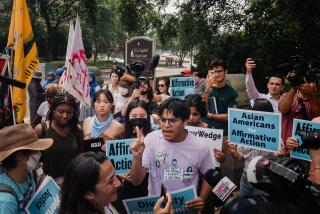Letters to the Editor: Anti-Asian hate is a symptom of old-fashioned American hate

To the editor: Your article on a recent report documenting anti-Asian hate incidents cites a group of students taunting a 10-year-old Chinese American child by shouting, “Corona, corona, corona.” That is reminiscent of the taunt, “Chinaman, Chinaman, sitting on a fence ...” of years past.
Anti-Asian hate is not new. It may be more acknowledged now, but it’s been alive and well on the streets, on school yards and in American politics forever.
Some have pointed out that many of the perpetrators have been Black men. Yes, these attackers committed heinous crimes, as did the white man who allegedly killed six Asian women in Georgia last March. But violence and hate know no color. The perpetrators and the victims are all part of an equal-opportunity reality.
What we have is not an anti-Asian hate problem; it’s just good old American hate. President Biden just acknowledged that the murder of more than 1 million Armenians in the Ottoman Empire was in fact genocide. Hate is universal.
Fight hate on all its fronts.
Warren Furutani, Gardena
..
To the editor: Your story explains how there were 2,800 anti-Asian hate incidents in the month of March compared to 3,800 in the whole year before. But the story was missing something important.
Not mentioning former President Trump in an article on anti-Asian hate is like writing about World War II without mentioning Adolf Hitler or the monsoon flooding in Thailand without mentioning rainfall.
Ted Bacino, Palm Springs
..
To the editor: I was disheartened to read UCLA business professor Christopher S. Tang’s op-ed article on discrimination against Asian Americans in corporate America. As a mid-level manager at AT&T Bell Labs in the 1970s and ‘80s, I saw firsthand the bias against Asian Americans.
A white senior director openly stated in a meeting that Asians were not management material. No Asian American had been promoted into upper management, although my own vice president had planned to promote me and warned that it wouldn’t happen if I became president of Asian Americans for Affirmative Action, or 4A, an employee advocacy group that I helped start.
We persisted and our work was so successful in raising awareness of anti-Asian bias that 4A was adopted by AT&T.
It’s discouraging that, more broadly, things haven’t changed much in the last 40 years. But with heightened awareness and corporate openness to change, it’s possible to increase Asian American representation in senior management, which is critical to staying competitive in our global economy.
Ron Osajima, Yorba Linda
More to Read
A cure for the common opinion
Get thought-provoking perspectives with our weekly newsletter.
You may occasionally receive promotional content from the Los Angeles Times.






